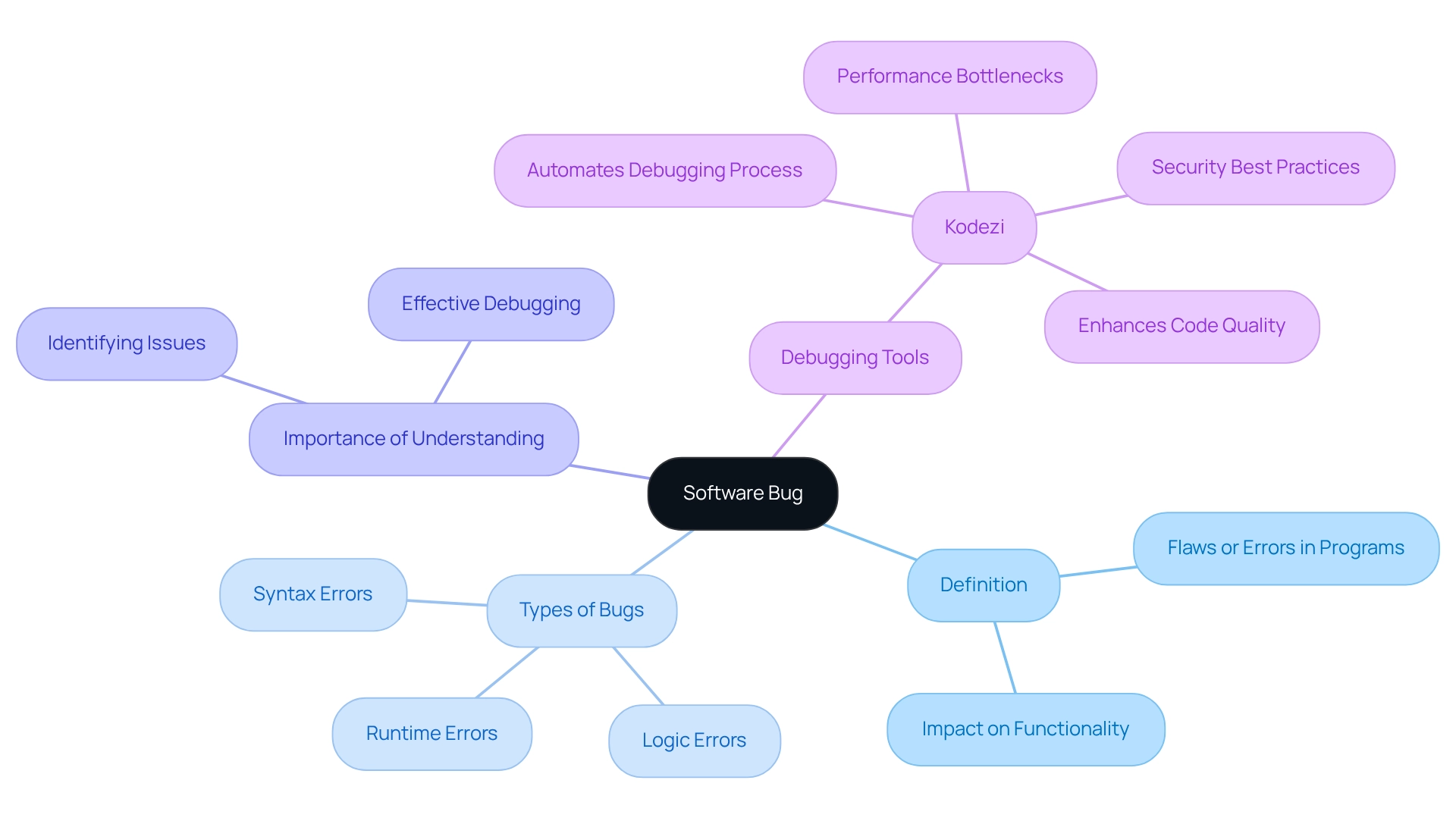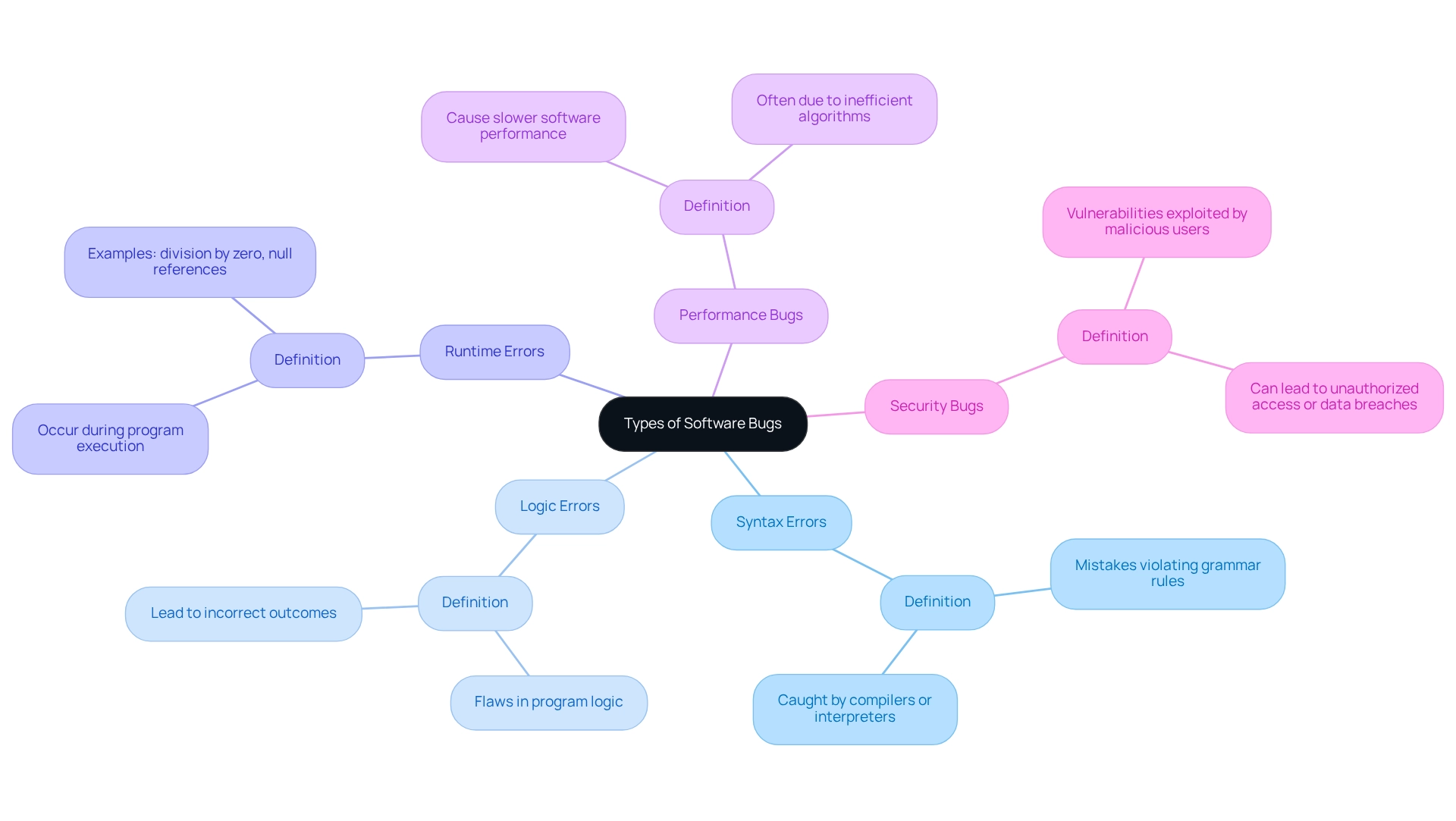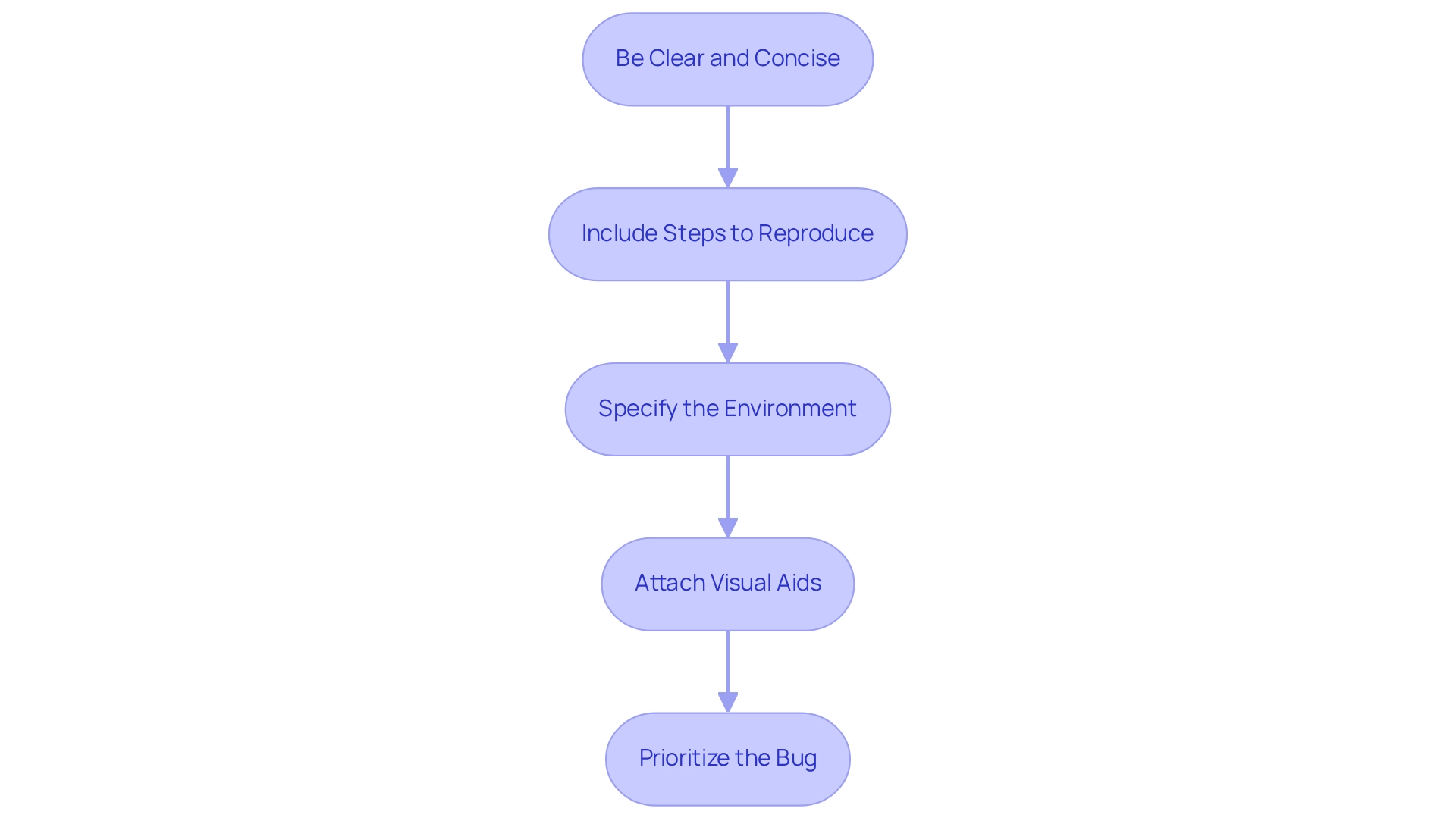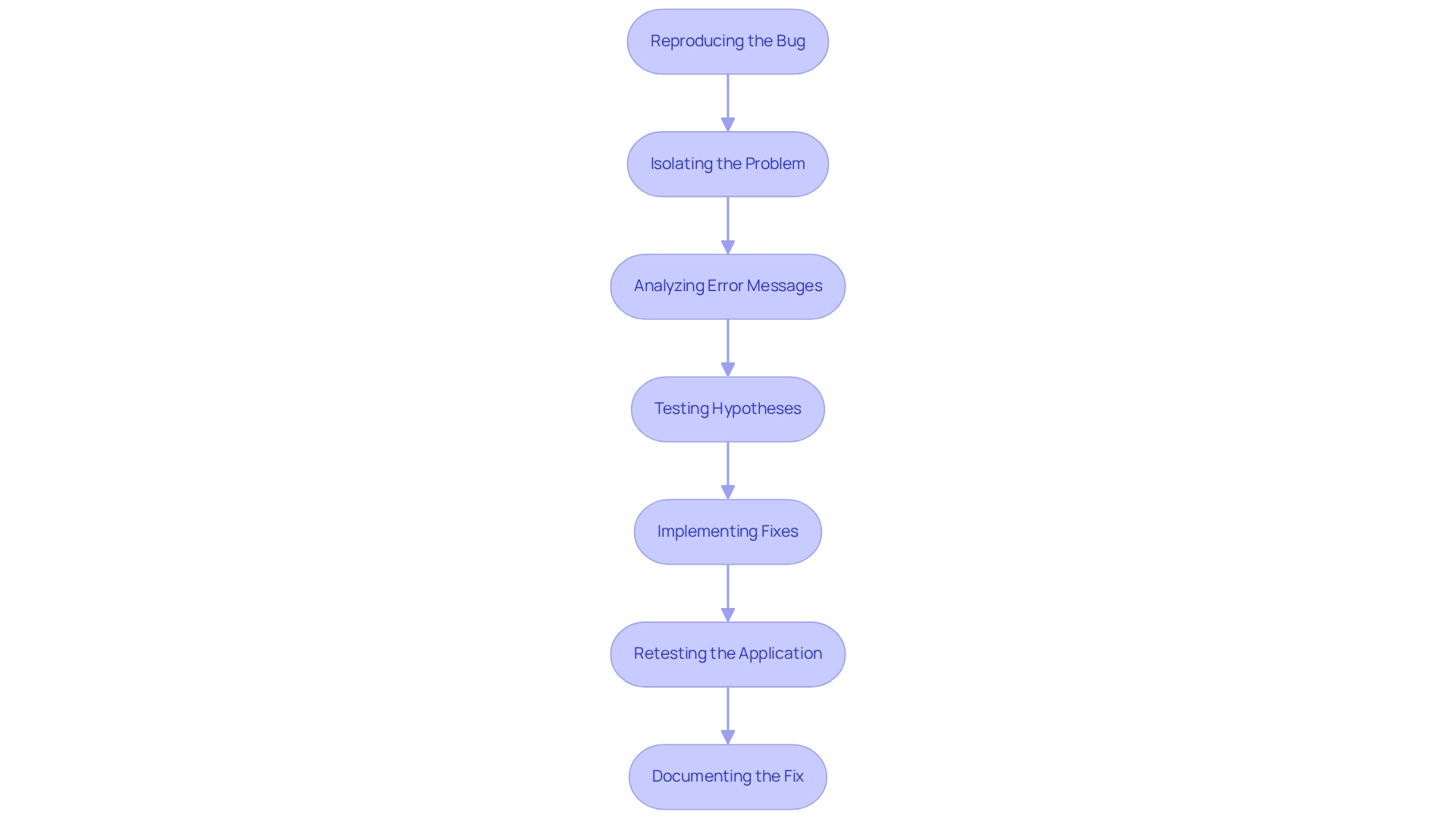Overview
In the world of software development, coding challenges are a common hurdle that developers face. Understanding software bugs—flaws or errors in computer programs that lead to incorrect or unexpected results—is crucial. These bugs can manifest in various forms, including syntax, logic, runtime, performance, and security errors. But how can developers effectively tackle these issues? Enter Kodezi, a powerful tool designed to assist developers in identifying and resolving bugs efficiently.
Kodezi offers specific features that streamline the debugging process, ensuring that developers can focus on what truly matters: writing quality code. By utilizing Kodezi, developers can enhance their productivity and improve application functionality. Imagine the time saved by quickly pinpointing errors and implementing fixes—how much more could you accomplish?
Furthermore, the best practices for documentation supported by Kodezi not only aid in debugging but also contribute to overall code quality. As developers embrace these tools, they can expect significant improvements in their workflow and project outcomes. So why not explore the features available on Kodezi? Discover how this innovative platform can transform your coding experience and lead to greater success in your projects.
Introduction
In the realm of software development, bugs present an unavoidable challenge that can disrupt functionality and hinder progress. These flaws, which can range from minor syntax errors to critical security vulnerabilities, often arise from various sources. Therefore, it is essential for developers to grasp their nature and classification. By mastering the art of bug identification, documentation, and resolution, programmers can streamline their workflow and enhance software quality.
Furthermore, with the advent of innovative tools like Kodezi, the debugging process has evolved significantly. Kodezi offers automated solutions that empower developers to tackle issues efficiently. Imagine being able to resolve bugs faster and more effectively—how much more productive could you be? This article delves into the fundamentals of software bugs, their classifications, and best practices for effective debugging. By equipping themselves with this knowledge, developers can maintain robust and secure applications while harnessing the full potential of tools like Kodezi.
Define Software Bug: Understanding the Basics
To define software bug, it refers to the common challenge that developers face, representing flaws or errors in computer programs that lead to incorrect or unexpected results. These bugs can arise from coding mistakes, design flaws, or external factors that impact software performance. Understanding how to define software bug is crucial for developers to identify issues that may disrupt application functionality. Bugs manifest in various forms, such as syntax errors, logic errors, or runtime errors, each necessitating distinct resolution approaches. Recognizing these differences is vital for effective debugging and optimization.
Furthermore, Kodezi offers a powerful tool that automates the debugging process, enabling developers to quickly identify and resolve codebase issues. With comprehensive explanations of what went wrong and how to fix it, developers can streamline their workflow. In addition, the tool addresses performance bottlenecks, ensures adherence to security best practices, and enhances code quality. This makes Kodezi an invaluable resource for developers seeking to improve productivity and overall code quality.
Are you ready to elevate your coding practices? Explore the tools available on the Kodezi platform today and experience the efficiency gains firsthand. By leveraging Kodezi, you can transform your approach to debugging and optimization, ensuring your applications run smoothly and securely.

Identify Types of Software Bugs: Common Classifications
Developers often face significant challenges when it comes to coding, particularly in defining software bugs and resolving them. Understanding how to define software bugs can significantly transform the development process. Kodezi offers powerful tools to help tackle these issues effectively.
Syntax Errors are mistakes in the code that violate the grammar rules of the programming language, often caught by compilers or interpreters. With Kodezi's automated debugging feature, developers can swiftly identify these errors, receiving recommendations for adjustments to ensure code adheres to language syntax.
Logic Errors are flaws in the program's logic that lead to incorrect outcomes, which may not be immediately apparent during execution. Kodezi aids developers in following the logic flow, helping to pinpoint where the logic deviates from expected behavior.
Runtime Errors occur while the program is running, often due to invalid operations, such as division by zero or accessing null references. The debugging tools from Kodezi can identify these problems in real-time, enabling prompt resolution.
Performance Bugs can cause the software to run slower than expected, often due to inefficient algorithms or resource management. Kodezi's automated code debugging feature allows developers to quickly recognize and resolve these performance bottlenecks, ensuring optimal software efficiency in seconds.
Security Bugs represent vulnerabilities that can be exploited by malicious users, leading to unauthorized access or data breaches. Kodezi ensures that your codebase adheres to the latest security best practices, assisting in identifying and resolving security concerns swiftly, which can help define software bug classifications for better diagnosis and targeted solutions. Kodezi's AI-driven automated builds and testing enhance code quality in software development. Why not explore the tools available on the Kodezi platform to elevate your coding experience?

Document and Report Bugs: Best Practices for Developers
When documenting and reporting bugs, developers often encounter significant challenges. To effectively address these issues, it is essential to follow best practices that enhance clarity and communication within teams.
Firstly, being clear and concise is crucial. Use straightforward language to describe the bug, steering clear of technical jargon that may confuse the reader. Furthermore, including steps to reproduce the bug is vital; provide a detailed sequence of actions that led to the issue, allowing others to replicate the problem easily.
In addition, specifying the environment is important. Mention the software version, operating system, and any relevant configurations that may affect the bug's occurrence. Attaching screenshots or logs can also be beneficial; visual aids help illustrate the problem more effectively, providing context that may be missed in text alone.
Another key practice is to prioritize the bug. Indicate the severity and impact of the bug on the application, which assists the team in prioritizing fixes based on urgency. By adhering to these practices, developers can significantly enhance communication within their teams and streamline how they define software bugs, ultimately improving productivity and code quality.

Debug and Fix Bugs: Step-by-Step Troubleshooting Techniques
For developers, it can be daunting to diagnose and resolve issues when they need to define software bug. To tackle these challenges effectively, consider leveraging the functionalities of the CLI through a structured troubleshooting approach.
To define a software bug, reproducing the bug is the first step; by replicating the issue, you gain insight into its context and behavior, which is crucial for identifying the root cause. The CLI can provide valuable insights that help define software bug occurrences in similar situations.
Isolating the Problem comes next. Narrow down the specific code section where the bug occurs, utilizing debugging tools to step through the code and monitor variable values. The CLI's autonomous capabilities can swiftly pinpoint problematic areas in the codebase.
Analyzing Error Messages is also essential. Pay close attention to any error messages or logs generated during the occurrence of the bug, as understanding how to define software bug can offer critical clues about the underlying issue. The CLI can analyze logs and recommend potential solutions based on historical data.
Testing Hypotheses is an iterative process where you formulate potential causes and validate them by modifying the code or environment. This methodical approach helps to accurately identify the problem. The CLI can automate several of these tests, saving you time and effort.
Implementing Fixes is the next logical step. Once the root cause is identified, apply the necessary changes to the code to define software bug fixes that resolve the problem while ensuring no new bugs are introduced. The CLI can assist in confirming that the modifications made do not lead to further issues.
Retesting the Application is crucial after implementing the fix. Thoroughly test the application to ensure that the bug is resolved and that no new issues have arisen. The CLI can streamline this process by executing automated tests.
Finally, Documenting the Fix is vital. Record the bug, its cause, and the solution in your bug tracking system to facilitate future debugging efforts and enhance team knowledge. The CLI can aid in documenting these changes effectively.
For a quick start, check out the '5-minute quickstart' guide and see a demo to learn how the CLI can enhance your debugging process. By following these techniques and utilizing Kodezi CLI, developers can significantly improve their debugging skills and elevate the overall quality of their software.

Conclusion
Understanding software bugs is paramount for any developer facing the challenges of coding. These bugs can significantly hinder application quality and functionality. The article provides a comprehensive overview of what constitutes a software bug, including its various forms—syntax, logic, runtime, performance, and security errors. By categorizing these bugs, developers can more effectively diagnose and address issues, ensuring that they maintain robust applications.
Furthermore, the importance of documenting and reporting bugs using clear and concise language cannot be overstated. By following best practices, developers can streamline communication within teams and facilitate quicker resolutions. The article also outlines step-by-step debugging techniques that, when paired with tools like Kodezi, can significantly improve efficiency in identifying and fixing bugs.
In addition, embracing these strategies and leveraging innovative tools such as Kodezi empowers developers to overcome the challenges posed by software bugs. By mastering the art of bug identification, documentation, and resolution, developers not only enhance their productivity but also contribute to the creation of more secure and reliable software. The journey to flawless code starts with understanding and addressing the bugs that can hinder progress.
Frequently Asked Questions
What is a software bug?
A software bug refers to flaws or errors in computer programs that lead to incorrect or unexpected results. These bugs can arise from coding mistakes, design flaws, or external factors impacting software performance.
Why is it important for developers to understand software bugs?
Understanding software bugs is crucial for developers to identify issues that may disrupt application functionality, allowing them to address these problems effectively.
What are the different types of software bugs?
Software bugs can manifest in various forms, including syntax errors, logic errors, and runtime errors, each requiring distinct resolution approaches.
How does Kodezi assist developers in debugging?
Kodezi offers a powerful tool that automates the debugging process, enabling developers to quickly identify and resolve codebase issues, along with providing comprehensive explanations of what went wrong and how to fix it.
What additional benefits does Kodezi provide beyond debugging?
Kodezi also addresses performance bottlenecks, ensures adherence to security best practices, and enhances overall code quality, making it an invaluable resource for developers.
How can developers explore the tools available on the Kodezi platform?
Developers can explore the tools on the Kodezi platform to experience efficiency gains and improve their coding practices, particularly in debugging and optimization.




